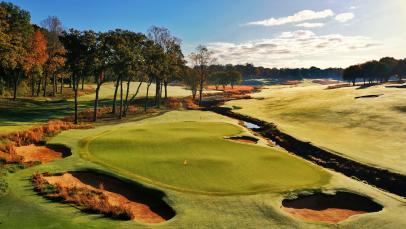radical journey
PGA Championship 2023: How Oak Hill will display the work of golf’s hottest new architect
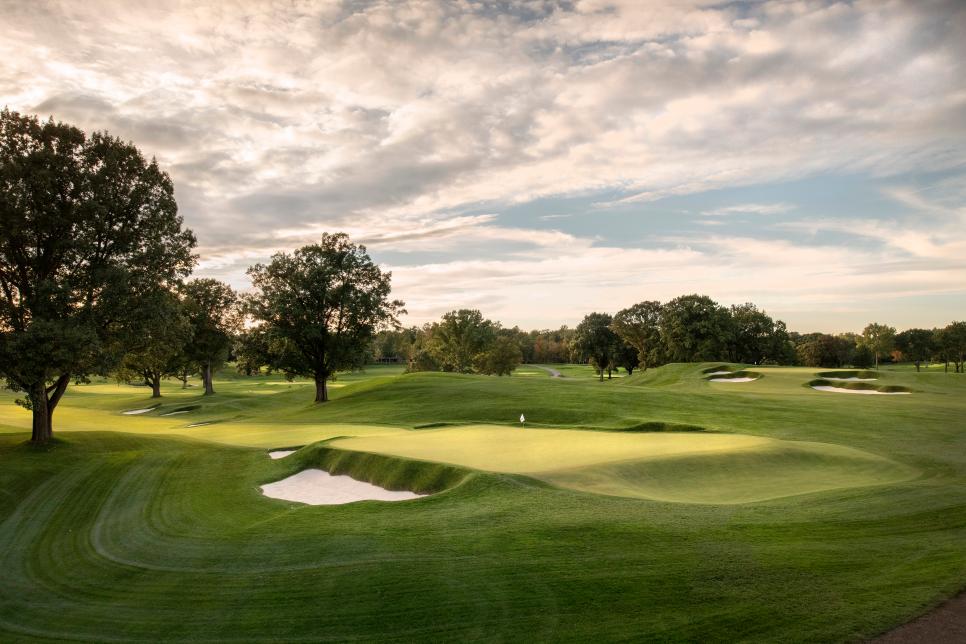
The PGA Championship will be played at Oak Hill in Rochester, N.Y., in May for the fourth time, placing it second only to last year’s host, Southern Hills. This might be misleading because no PGA Championship or any other major championship has been contested on the course the players will see this year. That course is gone. In 2019, the club orchestrated a near-total remodel of the East Course by architect Andrew Green, 45, who in a short period has become one of the most consequential designers in the business. Through seven decades hosting various national championships, the Donald Ross-designed East Course has been an archetype of American parkland golf, a showcase of fairways threaded through robust corridors of hardwoods and deep rough, with sloping greens rising from nests of bright white bunkers. Though few individual holes stood out, Oak Hill’s cumulative orchestration of trees, lush grass, shadows and perched putting surfaces provided a constant, green-noise backdrop for moments like Curtis Strange winning his second consecutive U.S. Open in 1989, the heartbreaking loss of the 1995 U.S. Ryder Cup team and Shaun Micheel’s stuffed 7-iron to two inches at 18 to clinch the 2003 PGA Championship.
Yes, Green’s work at Oak Hill changed its complexion entirely. He remodeled every green complex, fairway and landing zone to resurrect the original Ross character and spaciousness of the East Course that had been intentionally and unintentionally eradicated by 70 years of growth and architectural alteration. When Ross constructed the course in 1924 on mostly bare farmland (the property was already called Oak Hill, even though it had few trees), the holes were expansive with segmented, broad-shouldered greens and deep, scruffy bunkers. Green’s renovation moved Oak Hill back toward this complexion by reclaiming fairway widths, and through the removal of thousands of oaks, elms, maples and other varietals, opening up sightlines across the property unimaginable a decade ago when Jason Dufner held off Jim Furyk during the last PGA Championship played here. Three new holes were also built, and Green found more than 200 yards of additional teeing space, bringing the championship distance to just shy of 7,400 yards.
Oak Hill hasn’t been remodeled as much as it was reverse engineered to a state viewers and most players won’t recognize. The driving accuracy and shaping of shots around the boughs of trees so requisite to previous scoring will not be critical this time, though avoiding fairway bunkers and their tall vertical edges will be. High-trajectory approaches over bunkers and water blocking the fronts of greens were de rigueur, but most entrances now have been lowered and the hazards spaced to the flanks. Even more dramatic are the course’s new aesthetics that are based on historic photographs, with aggressive, steep-faced bunkering casting stark chiaroscuro shades against more exposed putting surfaces and horizon lines.
“There’s a certain rugged kind of boldness to what we’ve done that’s meant to provide a little more intimidation and to place some demanding circumstances on the world’s best players,” Green says. “The bunkers are certainly deep and steep, and there will be some fairway bunkers where, if golfers end up in them, they won’t be able to advance the ball all the way to the target. That may cause some of the professionals to have some questions.”
Why did Oak Hill embark on such a radical journey away from a presentation that epitomized for many what a major-championship venue should be? Why change a course that has never fluctuated beyond 11 and 27 on Golf Digest’s America’s 100 Greatest ranking?
Watch our exclusive drone tour
The answer begins in 1968. That’s the year Lee Trevino tied the U.S. Open scoring record of 275 at Oak Hill. In an era that valued strenuous golf above all else, having a course that was perceived as too easy is what kept prominent clubs up at night. Not only had Trevino, just a second-year tour player, matched the Open’s lowest score, but he shot four rounds in the 60s, a feat never before accomplished. Fearing the governing bodies would overlook a presumably lax East Course for future majors, Oak Hill hired player-turned-architect George Fazio and his partner-nephew Tom Fazio in 1976 to toughen up the East Course. “One thing that Oak Hill never presented to the great players was a really intimidating hole where you could make a big score,” a club official said at the time. “You can bogey any hole, but we never had a hole that was a double-bogey or triple-bogey threat.”
To get those triple-bogey threats on the card, the Fazios shuffled Oak Hill’s layout and created several new holes. Before the 1968 Open, Ross’ sixth hole, a quaint par 3 encircled by six bunkers, was taken out of play for congestion reasons and replaced by a longer but blander par 3 on the property’s previously unused northeast corner, beyond the fourth green (this became the fifth hole). The Fazios, in turn, abandoned that 10-year-old replacement par 3, then broke Ross’ long par-4 sixth (as it was numbered at the time) into two holes: the mid-length par-4 fifth with a small, elevated green nestled over a crook in Allen Creek; and the sixth, a mid-length par 3 with another small, elevated green that dropped off left and long into the same creek. They also built a new par-3 15th, shifting the green well to the right and adding a pond, and moved the 18th green forward away from the clubhouse.

DIG IT OUT OF THE DIRT Andrew Green is known as a hands-on designer and researcher. Photograph by Matt Hawthorne
The additions helped Oak Hill land the 1980 PGA Championship and, as requested, made the East Course more severe—at least to everyone but Jack Nicklaus, who won by seven strokes and was the only player under par. However, the new holes were out of place with the rest of the design. Most of the membership thought they debased the course.
Nevertheless, Oak Hill continued with this permutation until after the 2013 PGA when deteriorating green conditions prompted exploration into another renovation. This time the remediation of the Fazio holes was also on the docket, and the club asked Jeff Sluman, the 1988 PGA Championship winner and Rochester native who was intimately familiar with the East Course, to weigh in on their reconstruction. The architecture committee then sought proposals from top architects and renovation specialists, and at the urging of superintendent Jeff Corcoran they also interviewed Green, a relatively unknown designer who had just left McDonald & Sons, a golf-construction company, to go out on his own. The Oak Hill job represented a rare opportunity for the young architect, and Green dug in.
“The selling point for Andrew versus all those other individuals was the presentation he gave for the architecture review committee,” says Dr. James Mason, a member since the early 1980s. Green’s proposal went beyond improvements and reviving lost holes. Using vintage imagery and Ross’ diagrams and field notes, he demonstrated, hole by hole, how far off the intended program the East Course had strayed. Oak Hill had been one of Ross’ most ambitious designs, 36 holes (with the adjacent West Course) that he envisioned would be played in a variety of loops and configurations. Building it was an industrial feat requiring, according to newspaper reports, 165 laborers, dozens of teams of horses, six tractors and a couple of steam shovels to cut hills and mold the land. Green demonstrated how that ingenuity and expressiveness—and even some of the hazards— had been covered up in foliage, and how the greens and bunkers had regressed to a repetitive succession of saucers and ovals. The result was a course that encouraged a plodding and patient mode of golf that had grown increasingly linear in proportion to the course’s age. Green’s roadmap for restoring the Ross fundamentals opened eyes. “Within a very short window of time everyone looked around the room and said, This is our guy,” Dr. Mason says.
The Oak Hill project didn’t begin until 2019. In the intervening time, Inverness, another Ross-designed major-championship course in Toledo, Ohio, also hired Green. Like Oak Hill, Inverness had suffered a similarly panned renovation by George and Tom Fazio in the late ’70s that interjected several modernized holes into the classic layout. What began there as a basic bunker renovation became a full-scale remodel when Green asked the club officials if they would consider reworking the misfit Fazio holes with the rest of the course back into a style sympathetic to Ross. Green’s work at Inverness was widely lauded, and the renovations there and at Oak Hill helped inspire other past major-championship clubs like Congressional, Scioto and Wannamoisett to hire him to undertake their own transformative, historic-based remodels.

REUNITED The long par-4 sixth has been restored to Donald Ross’ original conception.
Dom Furore
Green’s rise to the top of the profession has been both long and meteoric, and perhaps surprising. Most designers, if they aren’t playing professionals or staked with a prominent family name, take a decade or more working small jobs before they are established. This was true for Bill Coore, Tom Doak, and Gil Hanse and Jim Wagner, who are Green’s chief rivals for the most prestigious renovation jobs. Green seemed to arrive on the scene having bypassed the hardscrabble, hand-to-mouth phase, but that obscures the reality that he spent 14 years honing all aspects of the craft for McDonald & Sons, who hired him out of Virginia Tech.
“It was evident back then that Andrew was one of the smarter guys we had been around,” says McDonald & Sons president and CEO John McDonald II. “He can see in his mind’s eye the design he wants, the shape and the philosophy, and he can put it into a plan. The other part that not many have is the ability to get on a machine and put that idea in the ground.”
‘GREEN REMODELED EVERY GREEN COMPLEX, FAIRWAY AND LANDING ZONE TO RESURRECT THE ORIGINAL ROSS CHARACTER AND SPACIOUSNESS.’
Green belongs to the family of architects who not only design holes but operate equipment—excavators, bulldozers and sand pros. Those who have worked with him commend his efficiency, organization and technical expertise, but seeing the architect shape his creations gives added confidence to the clubs that hire him. Though he has yet to design and build a new course, he’s an exhaustive researcher who can expose clubs, even in interviews, to particulars of their history they didn’t know or had forgotten. His skill in presenting a comprehensive vision of how great their courses can be, often in ways they haven’t conceived, has been critical to his success in landing such prominent renovations. His greatest skill may be inspiring clubs through his passion to appreciate their courses more deeply than before.
“He was one of the most humble people we interviewed, and he said to us, You have a national treasure here. It’s in the ground, and I’m just here to help you uncover it,” says Chris Brooks, a member who was instrumental in hiring him at Scioto where Green’s work has been as staggering in scope as it was at Oak Hill. “It was almost like an archeological dig for him. He went about it in such a different way than others we talked to. He was more interested in our history and uncovering what Ross intended here than anybody else.”
“You could sense his love of golf-course architecture, his love of the final product,” McDonald says. “He’s a very compelling orator when he’s talking about the golf course, and there’s a confidence level to what he does without projecting an air of cockiness.”
Proposing to clubs as established as Scioto, Inverness or Congressional that they consider moving off their current iterations and essentially rebuild something new demands extreme confidence but also intuition.
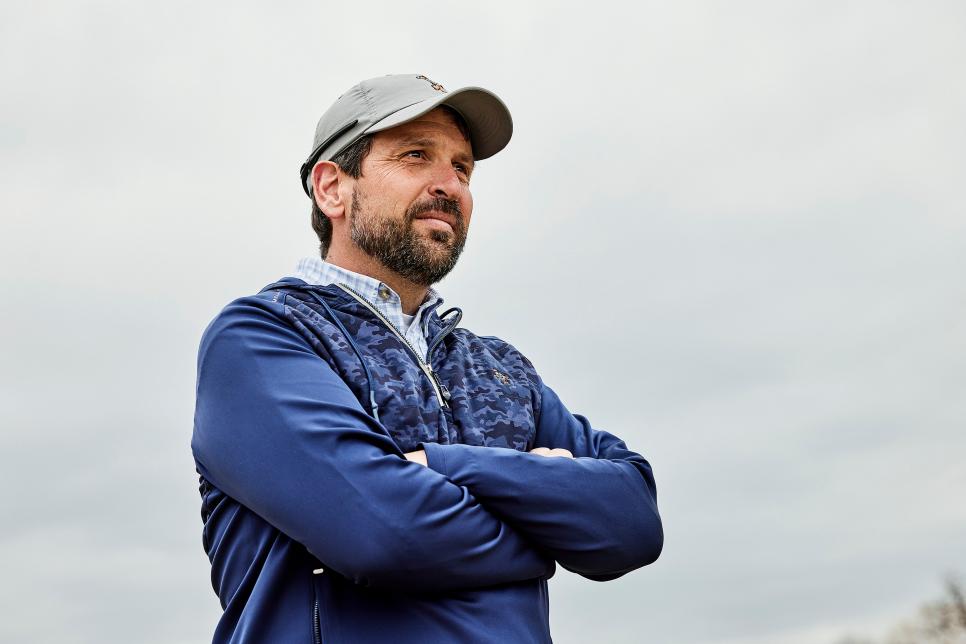
STAR TURN Green has become one of golf’s most consequential designers in a short time. Photograph by Matt Hawthorne
“Every inch of dirt mattered to him,” says a source close to the remodel of Congressional, where Green turned the club’s heavily wooded Blue Course, host of three previous U.S. Opens, into a proto-1920s landscape of rolling meadows and fescue transitions with 18 reimagined holes. “Nobody else saw moving the 10th hole to where it is now. Nobody else had the connection pieces.”
What Green saw at Oak Hill was a design that looked like an avatar of what happens to courses as they age, especially courses that revise themselves under the auspice of remaining relevant to the modern professional and elite amateur game.
“My initial thought was that the property was an all-star and that the original Ross routing was spectacular,” Green says. “He had done a phenomenal job of creating interesting golf shots and utilizing fairly simple but inspired topography. The opportunity to restore most of the routing was there.”
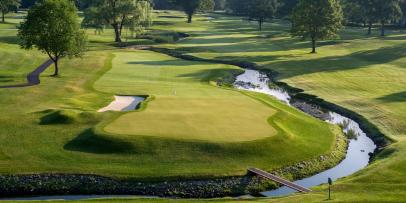
That began with recreating the holes that had been altered in the 1960s and ’70s. The area where Ross’ short par- 3 sixth was located could not be used because of through-traffic limitations and proximity to other holes (the green was located where the current seventh-hole tee complex is). Green took Ross’ drawings and rebuilt a replica of the par 3 in the location of the defunct par 3 that had been built for the 1968 Open (the club was using that corner of the East Course for short-game practice). The attractive new 180-yard hole plays as the fifth and sits prominently with a multilevel plateau green circled with four bunkers.
Adding the new fifth meant that Ross’ old fifth, once considered one of the country’s great par 4s before the Fazios cut it up into two holes, could be rebuilt. Green extended the putting surface of the Fazio fifth to its former location where the par-3 sixth green had been and reshaped it to Ross’ specs. The new sixth hole, a stout 500-yard par 4, now resembles the hole that Ross initially built with Allen Creek splitting the fairway 75 yards short of the green (instead of directly in front of it) and continuing up the left. Though he wasn’t able to move the par-3 15th green back to its 1925 home, 25 yards left of where it currently is, Green did rebuild it in the likeness of the Ross green, with two bunkers protecting the front and one running the length of the putting surface on the left. He also filled in the pond—that area is now a recessed chipping area sitting well below the tabletop green.
Oak Hill’s par-70 East Course will still be defined by its stellar par 4s, including the restored sixth and the long closing trio of 16, 17 and 18. The course has some intriguing short par 4s, too, including the stylish uphill second with a blind, narrow green set above deep trench bunkers, the 12th that plays through a gauntlet of bunkers to a putting surface benched into a sharp hillside, and the dramatic 320-yard, uphill 14th that will entice players to attempt to drive the green, though misses short will leave them in bunkers well below the putting surface, and shots that go over the green are likely to roll off the property.
All the remodeling work makes Oak Hill a more diverse and interesting course than it was, one that allows players to be more aggressive off the tee than in the past but requires careful calculation hitting shots into the greens.
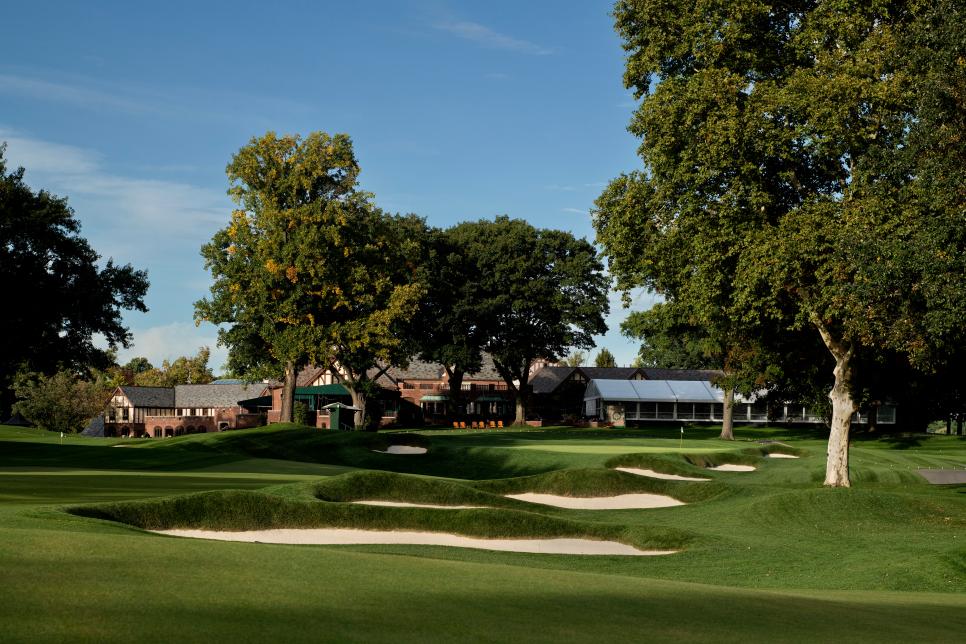
THE LAST STEP Oak Hill’s difficult, fate-making 18th hole.
Dom Furore
“I think Oak Hill is an all-time driver’s golf course, where the fairways are typically 26 to 28 yards wide, and you’re seriously out of position if you’re in the rough,” says Sluman, who played in the final group with winner Jay Haas in the 2008 Senior PGA Championship on the East Course. The winning score that year was seven over par. “You really have to drive the ball straight,” he says, “even though off the tee there’s more room now to swing a ball left to right or right to left.”
Green preserved the interior contours of most of the putting surfaces but recaptured green space around the perimeters, squaring off many of the edges the way Ross had. Greens like one, three, eight and 11 have tantalizing corners, lobes and appendages, meaning that flags can be moved to a greater range of locations than they had previously (some greens had so much build-up around the bunkers that they were down to just two or three hole locations). If he chooses—and depending on course conditions that can be cold and blustery in Rochester in May—PGA of America chief championships officer Kerry Haigh can stick holes in little nooks and near bunker faces, daring players to take on the shot. “The front left pin on nine is going to be amazingly difficult to go at because you’re shooting uphill, and looking into the horizon it doesn’t even look like it’s on the green,” Sluman says. “It’s going to lead to a lot of bogeys if guys start going for it.”
The new dynamics give Oak Hill’s membership more freedom to play, to hit a variety of shots and recover. It should also prove an entertaining test for the professionals, who will be tempted to flex their muscles. If the remodel helps the East Course get back to crowning champions like Nicklaus, Trevino and Cary Middlecoff (winner of the 1956 Open) and their 27 combined major titles like it used to, the club won’t have to do anything more to entice the USGA or PGA of America to come back.

